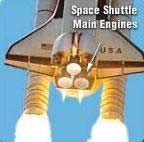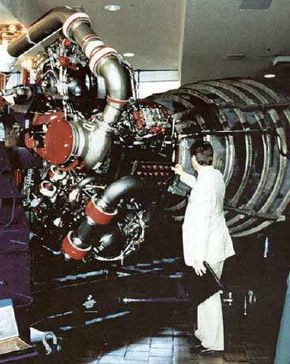Launching the Space Shuttle
To lift the 4.5 million pound (2.05 million kg) shuttle from the pad to orbit (115 to 400 miles/185 to 643 km) above the Earth, the shuttle uses the following components:
- two solid rocket boosters (SRB)
- three main engines of the orbiter
- the external fuel tank (ET)
- orbital maneuvering system (OMS) on the orbiter
Let's look at these components closely.
Advertisement
Solid Rocket Boosters
The SRBs are solid rockets that provide most of the main force or thrust (71 percent) needed to lift the space shuttle off the launch pad. In addition, the SRBs support the entire weight of the space shuttle orbiter and fuel tank on the launch pad. Each SRB has the following parts:
- solid rocket motor - case, propellant, igniter, nozzle
- solid propellant fuel - atomized aluminum (16 percent) oxidizers - ammonium perchlorate (70 percent) catalyst - iron oxide powder (0.2 percent) binder - polybutadiene acrylic acid acrylonite (12 percent) curing agent - epoxy resin (2 percent)
- jointed structure
- synthetic rubber o-rings between joints
- flight instruments
- recovery systems parachutes (drogue, main) floatation devices signaling devices
- explosive charges for separating from the external tank
- thrust control systems
- self-destruct mechanism
Because the SRBs are solid rocket engines, once they are ignited, they cannot be shut down. Therefore, they are the last component to light at launch.
Main Engines
The orbiter has three main engines located in the aft (back) fuselage (body of the spacecraft). Each engine is 14 feet (4.3 m) long, 7.5 feet (2. 3 m) in diameter at its widest point (the nozzle) and weighs about 6,700 lb (3039 kg).

The main engines provide the remainder of the thrust (29 percent) to lift the shuttle off the pad and into orbit.
The engines burn liquid hydrogen and liquid oxygen, which are stored in the external fuel tank (ET), at a ratio of 6:1. They draw liquid hydrogen and oxygen from the ET at an amazing rate, equivalent to emptying a family swimming pool every 10 seconds! The fuel is partially burned in a pre-chamber to produce high pressure, hot gases that drive the turbo-pumps (fuel pumps). The fuel is then fully burned in the main combustion chamber and the exhaust gases (water vapor) leave the nozzle at approximately 6,000 mph (10,000 km/h). Each engine can generate between 375,000 and 470,000 lb (1,668,083 to 2,090,664 N) of thrust; the rate of thrust can be controlled from 65 percent to 109 percent maximum thrust. The engines are mounted on gimbals (round bearings) that control the direction of the exhaust, which controls the forward direction of the rocket
External Fuel Tank
As mentioned above, the fuel for the main engines is stored in the ET. The ET is 158 ft (48 m) long and has a diameter of 27.6 ft (8.4 m). When empty, the ET weighs 78,000 lb (35,455 kg). It holds about 1.6 million lb (719,000 kg) of propellant with a total volume of about 526,000 gallons (2 million liters).
The ET is made of aluminum and aluminum composite materials. It has two separate tanks inside, the forward tank for oxygen and the aft tank for hydrogen, separated by an intertank region. Each tank has baffles to dampen the motion of fluid inside. Fluid flows from each tank through a 17-inch (43 cm) diameter feed line out of the ET through an umbilical line into the shuttle's main engines. Through these lines, oxygen can flow at a maximum rate of 17,600 gallons/min (66,600 l/min) and hydrogen can flow at a maximum rate of 47,400 gallons/min (179,000 l/min).
The ET is covered with a 1-inch (2.5 cm) thick layer of spray-on, polyisocyanurate foam insulation. The insulation keeps the fuels cold, protects the fuel from heat that builds up on the ET skin in flight, and minimizes ice formation. When Columbia launched in 2003, pieces of the insulating foam broke off the ET and damaged the left wing of the orbiter, which ultimately caused Columbia to break up upon re-entry.
Next, we'll look at the orbital maneuvering system and liftoff.
